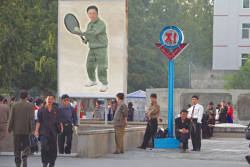Daily NK
Lee Sung Jin
12/23/2008
North Korea, since December 3rd, has been holding a “Competition for Revolutionary Descendants” in each province, over two days. The competition is the third of its kind, following on from 1998 and 2002.
A source confirmed in a phone conversation with the Daily NK on the 21st, “In Hyesan, Yangkang Province, from December 3rd, there was a “Competition for Revolutionary Descendants.” This competition took place simultaneously in each province.”
Another source said, “There was a competition in Chongjin, North Hamkyung Province in early December and many gifts, including clothing, were given out to the participants.”
The competition was held to stabilize the volatile state of affairs, spurred by rumors of Kim Jong Il’s illness, issues of food shortages, and the distribution of flyers in North Korea, by intercepting in advance any possible unrest among the core class.
(* North Korea categorized the population into the “core class (3,915,000),” the “unstable class (3,150,000),” and the “hostile class (7,935,000)” in 1971)
The Yangkang-based source said, “The competition was held with participation from the Party Chief Secretary of the province, the key officials in the province, city and county and chairpersons of the Peoples’ Units, descendants of revolutionaries and war veterans were invited to the competition.”
He then said, “Rather than being a real competition, it was a gathering to provide meals and distribute gifts. On the morning of the third day, after a flower-basket presentation ceremony at the Kim Il Sung memorial at the Bocheonbo Combat Victory Monument, a meeting was held at the Kim Jong Suk Arts Theater.”
He further noted, “At the meeting, there was a political lecture given by the new Propaganda Secretary of the Party in the Province Kim Bong She, after the congratulatory address by the Chief Secretary of the Province. Kim closed the event with a speech urging emulation of the lofty example of the first generation of revolutionaries, who devoted everything to the General.”
According to the source, after the event wrapped up its main events on the afternoon of the 3rd, it continued until the evening on the 4th with a special performance by the Yangkang Provincial Performing Arts Troupe, a special banquet, a visit to the Yangkang Province Revolutionary Historical Site, and a ceremony for presenting gifts.
The source said, “The authorities put in a lot of preparation for the event. They even brought beer, luxury alcohol and cigarettes from Pyongyang for the competition participants. Also, there were special performances at the Yalu Restaurant, a famous restaurant in Hyesan, at the Hyesan Shopping Center restaurant, and at restaurants in various train stations.”
The source explained, “The officials went out of their way to shake hands with the competition participants and urged, ‘In such difficult times, we have to submit to the guidance of the General.”
He said, “At the competition, the issue of the Party’s active support for the children of deceased revolutionaries and needing to look after their needs was raised more than once. In particular, the provision for and subsistence of the descendants, due to difficult economic conditions, had been neglected, but the promise was made that, from now on, the Party in Yangkang Province would take an interest in and resolve the issue.”

